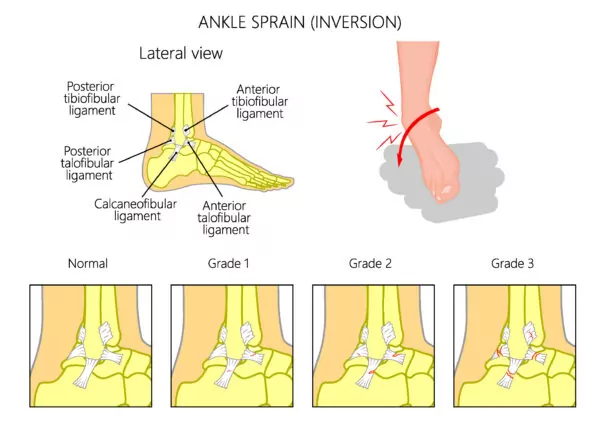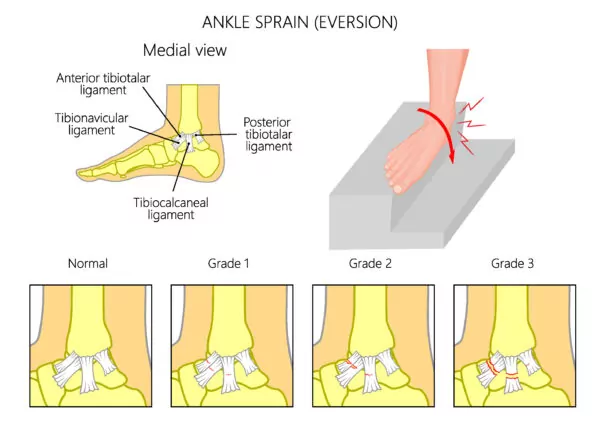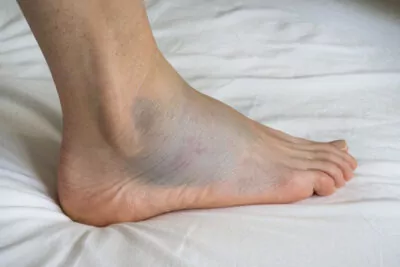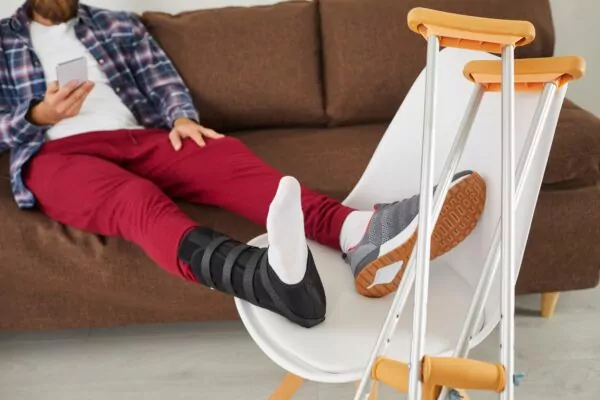How to Treat a Sprained Ankle
Symptoms, Diagnosis, Treatment, and Recovery
What is an Sprained Ankle?
An ankle sprain usually occurs when the ankle is twisted, causing injury to the soft tissue of the ankle. This occurs most commonly during athletic activities or with awkward falls from a curb or a step. They are one of the most common injuries that we treat in our practice. It is also estimated that millions of people suffer an ankle sprain each day.
Ankle Sprain Grades

Within the ankle there are numerous tendons and ligaments however, when an Ankle Sprain occurs, it typically involves the ligaments specifically.
To define, a ligament is a thick band of tissue that connects bone to bone. A sprain of the ankle results in the stretching or tearing of one or more of these ligaments.
There are a few different severities, otherwise referred to as ‘grades’, of an Ankle Sprain. These grades range from one (1) to three (3).
A Grade One (1) ankle sprains is a stretch of the ligaments.
Grade Two (2) ankle sprains are partial tears of the ligaments within the ankle.
A Grade Three (3) ankle sprain is a complete tear of the ligaments.
High Ankle Sprains vs Low Ankle Sprains
If you’ve injured your ankle before, you may have heard the terms ‘High Ankle Sprain’ and ‘Low Ankle Sprains’. To differentiate the two, a High Ankle Sprain is when the sprain damage occurs at the high ankle ligaments that connect from the tibia to the fibula.

Alternatively, a Low Ankle Sprain involves the ligaments just below the ankle joint, commonly referred to as the subtalar joint. Click here to learn more about the subtalar joint and additional Ankle Anatomy.
Low ankle sprains can be further classified as Inversion Sprains or Eversion Sprains. The majority of ankle sprains tend to be inversion ankle sprains and occur when the ankle rolls inwards. Whereas, an eversion ankle sprains occurs when the ankle rolls outward.


How to Treat a Sprained Ankle
Sprained Ankle Symptoms
Soon after the initial injury occurs, the ankle will become swollen, painful, and can be accompanied by excessive bruising. You will also notice moving or walking on the ankle can be very difficult due to the pain and swelling.

Ankle Sprain Diagnosis
At Colorado Springs Orthopaedic Group (CSOG) and within our orthopaedic urgent care, CSOG Express Care, we can help make the initial diagnosis of an ankle sprain through an in-person examination. In conjunction with this exam, we will take X-ray images of your ankle to confirm that there is not a break in any of the ankle bones. Many patients ask if an MRI is needed to confirm the degree of an ankle sprain. To answer this, an MRI of your ankle is not always apart of the initial image ordering. It can however, be warranted and ordered if your ankle fails to improve after a period of prescribed physical rehabilitation.
Sprained Ankle Treatment and Recovery
Treatment can begin by using the PRICE principle: Protection, Rest, Ice, Compression, and Elevation.
In addition to using the PRICE principle, a walking boot or brace is used to protect your ankle and allow the ankle ligaments to rest in a favorable position.
Crutches can also help prevent any weight bearing on the ankle, and casts may be used in severe ankle sprain cases. The healing of the ligaments usually takes around six (6) weeks, but the swelling may be present for several months.
After one (1) to three (3) weeks of rest and rehabilitation, we can begin Physical Therapy and proceed based upon the sprain’s severity. Depending upon the degree (grade) of the ligament damage, long term physical therapy and/or surgery may be suggested.

Chronic Ankle Sprains
Chronic ankle sprains are generally considered those that occur repeatedly however, they can also be sprains that have failed to improve over a significant period of time. This is usually the result of inadequate initial treatment of a recent ankle sprain or due to a very severe original ankle sprain.
When the ankle is not treated correctly after the initial sprain, then the ligaments can heal in a stretched out fashion leading to what’s known as a “loose” ankle. Those with loose ankles tend to have a lack of confidence in their ankle stability and suffer from weak ankles that may hurt and give out frequently.
If this is the case, when you are seen by a physician at Colorado Springs Orthopaedic Group, they may refer you to our in-house orthotic team at Audubon Orthotics and Prosthetics Services, to fit you with a stabilizing ankle brace in efforts of preventing future re-injury.
If you have suffered an ankle sprain or have experienced multiple ankle sprains, do not hesitate to reach out to the Foot and Ankle Center at CSOG. After a thorough evaluation to include X-Ray and potentially MRI imaging, our team will work with you to develop an individualized plan to make sure you regain confidence in your ankle stability for the long term.
Meet Our Providers

Brad Dresher, MD

G. Alex Simpson, DO

Kristina Hoffmann, PA-C



